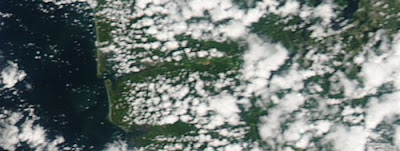Yesterday I told people who wanted to view the transit of Venus along the coast to go as close to the water as possible...why?
There is often a major difference between the amount of clouds offshore or right on the coast and just a short distance inland, with clouds increasing inland--so being right on the coast really increased the chances of seeing the transit of Venus yesterday.
Here is an example of the effect. First, a visible satellite picture from the GOES satellite at 3 PM yesterday (about when the transit started!). There was some clouds and convective showers offshore, but look what happens as the air crosses the coast...you can see lines of small cumulus developing, aligned in cloud "streets" parallel to the winds. You can also view the convergence zone over Puget Sound and the enhanced clear zones to the north and south...many of you wisely headed there.
We can get a better view of the development of coastal clouds from another satellite: the polar-orbiting MODIS system. Here are two pictures from it, with horizontal resolutions of 250 meters. The first image is along and east of the central WA coat and the second southern Vancouver Is. You can really see the effect in this images...relatively cloud free offshore and on the immediate coas,t with clouds developing inland. You notice that some of the clouds even get bigger inland.
High-resolution weather forecasting models, like the UW WRF model run at 1.33 km grid spacing, can produce this observed cloud distribution. Here is a sample from yesterday
for a forecast valid at 3 PM. Not bad...and it also got the convergence zone clouds and the clear zones to the north and south.
So why do clouds form just inland along the coast, particularly during the day (this phenomenon is far less prevalent at night).
This time of the year the sun is quite strong and is able to heat up the land substantially when a solid overcast is not overhead. The water offshore is cool (roughly 50F). When cool air moves over the warm land, we have a large change of temperature with height. Such large vertical temperature changes can cause the air to convect, producing upward thermals and cumulus clouds. This is quite similar to what happens in your saucepan when you turn on the burner...a large change in temperature with height causes your cereal to convect.
This convection takes a time to develop, so there it is a mile or so inland before clouds start forming in a significant way.
The development of coastal clouds is also helped along by what is called coastal frictional convergence. This is the kind of terminology that will impress your friends and fascinate folks at cocktail parties. The ocean surface is aerodynamically relatively smooth (little friction) and thus winds over water are strong. Over land the surface is far rougher and that slows down the winds.
So if air is moving inland (eastward)....fast moving air from the ocean meets air that is moving more slowly over land. Air get piled up and some of the air is forced to rise...this is the coastal convergence. Rising air produces clouds.
Finally, in many parts of the Pacific coast there is terrain just inland, terrain that causes air to rise...and yes....forming clouds.
So for a number of reasons, expect more clouds as one moves inland from the shore. Another reason that hotels on the coast can charge more than their brethren a few miles inland.
This blog provides forecasts weather or other topics
Subscribe
Popular post
-
The Weather Choice On Saturday One of the most marvelous aspects of our weather are the contrasts on nearly any day with a little driving......
-
I didn't want to mention this, worrying I might jinx it, but it is clear that August 2012 will the driest in Seattle history. So far we...
-
For over 15 years, I have talked about Northwest weather, the weekend forecast, and education-related topics on KUOW during Friday's mo...
-
This blog contains material that may be inappropriate for preteen audiences, so if you are underage, please click here . For the rest of you...
-
As I mentioned in an earlier blog, January 2010 was the warmest on record in Seattle (back to 1891) and one of the warmest years at virtual...
-
This time of the year there are real differences in wind speed during various times of the day and in virtually all locations it is windiest...
-
Although there is a lot of media coverage of the damage and destruction accompanying tropical storms and hurricanes, such storms can also ha...
-
Today, Senator Maria Cantwell announced that the new coastal radar would be installed one year earlier than initially planned--thus, it sho...
-
Seattle after a recent fireworks show Wake up with a little cough this morning? Did the air in your neighborhood last night seem more like ...
-
Last night there was some thunderstorms and rain from the central Sound northward associated with an upper level low/trough over the region ...
Blog Archive
-
▼
2012
(151)
-
▼
June
(20)
- Sky Poet
- Battling Extremes and the July 4th Forecast
- Cascade Melt Out
- Summer Squall
- Saturday morning update
- Wet Day and Hard Forecast
- Now is the Time to Fix the Math Meltdown in Seattl...
- Why are coastal water temperatures cooling?
- Feeling a bit tropical outside?
- Weather-X
- Ocean Full of Clouds
- Troubles at the National Weather Service
- Seasonal Precipitation Surprises
- Depressing But True
- Coastal Clouds
- Last Venus Transit Update
- Venus Transit Weather Update
- Venus Transit Update
- Where to See the Transit of Venus?
- Coal Trains: Bad for the Northwest Environment
-
▼
June
(20)
Powered by Blogger.
Support :
Creating Website | Johny Template | Mas Template
Copyright © 2011. The Weather - All Rights Reserved
Copyright © 2011. The Weather - All Rights Reserved













